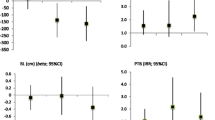Summary
We examined whether the prenatal detection of family violence and initiation of a comprehensive prenatal individualised care program could ameliorate the impact of family violence on maternal attachment to her infant at 6-months of age. An assessment of domestic violence was established for each subject at the 1st antenatal visit and women were classified as being exposed to domestic violence in pregnancy (EDV) or as being not exposed to domestic violence. Outcomes were determined 6 months postpartum. Of 173 consecutive women who met the eligibility criteria, consent was obtained from 150 (87% response). Women who had been subjected to domestic violence showed reduced overall attachment scores to their infants. Following multivariate analysis, drug use in pregnancy and domestic violence showed a significant independent effect on maternal attachment. Drug abuse and domestic violence were also associated with an increase in the easy-difficult scale of infant temperament. Thus, despite excellence in prenatal care, drug abuse and domestic violence were associated with poorer maternal attachment and assessment of infant temperament, suggesting that additional interventions are still required.
Similar content being viewed by others
References
K Asling-Monemi R Pena MC Ellsberg LA Persson (2003) ArticleTitleViolence against women increases the risk of infant and child mortality: a case-referent study in Nicaragua. Bull WHO 81 10–16 Occurrence Handle12640470
L Bensley J Van Eenwyk K Wynkoop Simmons (2003) ArticleTitleChildhood family violence history and women’s risk for intimate partner violence and poor health. Am J Preven Med 25 38–44 Occurrence Handle10.1016/S0749-3797(03)00094-1
Chalk R, King P (eds) (1998) Violence in families: assessing prevention and treatment programs. National Academy Press, Washington, DC.
JT Condon CJ Corkindale (1998) ArticleTitleThe assessment of parent-to-infant attachment: Development of a self-report questionnaire instrument. J Reprod Infant Psych 16 57–76
JL Cox JM Holden R Sagovsky (1987) ArticleTitleDetection of postnatal depression. Br J Psychiatry 150 782–786 Occurrence Handle3651732
MK Ehrensaft P Cohen J Brown E Smailes H Chen JG Johnson (2003) ArticleTitleIntergenerational transmission of partner violence: a 20-year prospective study. J Consult Clin Psychol 71 741–753 Occurrence Handle10.1037/0022-006X.71.4.741 Occurrence Handle12924679
Karen R (1998) Becoming attached: First relationships and how they shape our capacity to love. Oxford University Press, New York.
KM Kitzmann NK Gaylord AR Holt ED Kenny (2003) ArticleTitleChild witnesses to domestic violence: a meta-analytic review. J Consult Clin Psychol 71 339–352 Occurrence Handle10.1037/0022-006X.71.2.339 Occurrence Handle12699028
DL Mahony JM Campbell (1998) ArticleTitleChildren witnessing domestic violence: a developmental approach. Clin Excel Nurse Pract 2 362–369
L McKie (2003) ArticleTitleReview article: gender, violence and health care: implications for research, policy and practice. Sociol Health Illness 25 120–131 Occurrence Handle10.1111/1467-9566.00327
McLennon W (1996) Women’s Safety Survey. Australian Bureau of Statistics, Canberra, Australia.
T Moran (1995) ArticleTitle‘I fell down the stairs.’ Physicians can help by learning to recognize the signs of domestic violence. Texas Med 91 18–21
L Murray A Fiori-Cowley R Hooper P Cooper (1996a) ArticleTitleThe impact of postnatal depression and associated adversity on early mother-infant interactions and later infant outcome. Child Dev 67 2512–2526
L Murray A Hipwell R Hooper A Stein P Cooper (1996b) ArticleTitleThe cognitive development of 5-year-old children of postnatally depressed mothers. J Child Psychol Psych Allied Dis 37 927–935
L Murray D Sinclair P Cooper et al. (1999) ArticleTitleThe socioemotional development of 5 year-old children of postnatally depressed mothers. J Child Psychol Psychiat Allied Dis 40 1259–1271 Occurrence Handle10.1017/S002196309900476X
F Oberklaid AV Sanson et al. (1986) ArticleTitleThe development of Australian normative data for infant temperament. Aust Paediatr J 22 IssueID3 185–187 Occurrence Handle3767786
F Oberklaid M Prior D Golvan A Clements A Williamson (1984) ArticleTitleTemperament in Australian infants. Aust Paediatr 20 181–184
JM Pascoe NS Ialongo WF Horn MA Reinhart D Perradatto (1988) ArticleTitleThe reliability and validity of the maternal social support index. Fam Med 20 271–276 Occurrence Handle3203834
Prior MR, Sanson AV, Golvan D, Clements A, Williamson A (1989) The Australian temperament project. In: Kohnstamm GA, Bates JE (eds), Temperament in childhood. John Wiley & Sons, New York, pp 537–554.
JA Quinlivan SF Evans (2001) ArticleTitleA prospective cohort study of the impact of domestic violence on young teenage pregnancy outcomes. J Pediatr Adol Gynecol 14 17–23 Occurrence Handle10.1016/S1083-3188(00)00078-4
JA Quinlivan SF Evans (2004) ArticleTitleTeenage antenatal clinics may reduce the rate of preterm birth: a prospective study. BJOG 111 551–578
JA Quinlivan H Box SF Evans (2003) ArticleTitlePostnatal home visits in teenage mothers: A randomised controlled trial. Lancet 361 893–900 Occurrence Handle10.1016/S0140-6736(03)12770-5 Occurrence Handle12648967
Rosenberg M, Fenley M (1991) Violence in America. A public health approach. Oxford University Press, New York.
D Sinclair L Murray (1998) ArticleTitleEffects of postnatal depression on children’s adjustment to school. Teacher’s reports. Br J Psychiatry 172 58–63 Occurrence Handle9534834
A Taket J Nurse K Smith J Watson J Shakespeare V Lavis K Cosgrove K Mulley G Feder (2003) ArticleTitleRoutinely asking women about domestic violence in health settings. BMJ 327 673–676 Occurrence Handle10.1136/bmj.327.7416.673 Occurrence Handle14500444
Tjaden P, Thoennes N (2000) Full report of the prevalence, incidence and consequences of violence against women: Research Report. National Institute of Justice, Washington, DC, NCJ 183781.
U.S. Department of Health and Human Services (1995) Healthy people 2000: Midcourse review and 1995 revisions. U.S. Department of Health and Human Services Washington, DC.
CN Wathen HL MacMillan (2003) ArticleTitleInterventions for violence against women: scientific review. JAMA 289 589–600 Occurrence Handle10.1001/jama.289.5.589 Occurrence Handle12578492
Author information
Authors and Affiliations
Rights and permissions
About this article
Cite this article
Quinlivan, J., Evans, S. Impact of domestic violence and drug abuse in pregnancy on maternal attachment and infant temperament in teenage mothers in the setting of best clinical practice. Arch Womens Ment Health 8, 191–199 (2005). https://doi.org/10.1007/s00737-005-0079-7
Received:
Accepted:
Published:
Issue Date:
DOI: https://doi.org/10.1007/s00737-005-0079-7



